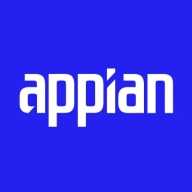

Find out what your peers are saying about Camunda, Automation Anywhere, SAP and others in Business Process Management (BPM).
They see return on investment in terms of cost savings, time savings, more efficient processes, and more efficient employees.
Appian is very efficient, allowing us to build a lot of applications within a financial year, making it cost-effective.
The technical support for Appian rates as 10 out of 10 because they have a great support team.
Their customer service is responsive, and the team is very prompt for support.
The technical support is generally good.
I am totally satisfied with the response time and quality of support.
Not all requests are attended to promptly.
We have our own internal team that supports the deployment process.
On a scale of one to 10, Appian rates as a nine for scalability.
Initially, without much coding, I can easily handle five thousand records.
Appian is scalable, but it depends on how you build your applications.
Currently, we are upgrading from 4.12 to 4.18, and after migrating the DC, our applications run smoothly without any challenges or slowness.
SAP HCM is quite scalable.
It depends on how it has been designed and how it has been configured.
The stability of Appian would rate as nine, as it's a stable environment.
I would rate its stability as nine out of ten.
I would rate the stability of SAP HCM as seven out of ten.
It has room to improve for use cases where the users are public facing, where anonymous users could come to a site and run a business workflow or interact with some data.
I would like to see more enhancement in the user interface to allow more freedom in designing the sites and pages.
If there is a very complex process that includes a lot of data transitioning and memory-centric processes, it consumes a lot of memory.
SAP HCM needs to be more customizable to fit unique organizational processes.
We are able to optimize a lot of processes but there is always room for improvement.
We sometimes face issues in the minor version, requiring us to upgrade to the major version.
On the pricier side, both Appian and Pega are enterprise-level solutions, placing them on the slightly higher side.
The price of Appian, on a competitive landscape, is a little bit on the higher side for companies, rating maybe a 6.5.
The pricing of Appian is based on the number of users and generally ranges from 70 to 100 USD per user per month.
I would rate pricing for SAP as one because the price is high.
SAP HCM is quite expensive, but considering solutions like Oracle, they are similar.
SAP HCM is costly compared to other ERPs like Microsoft Dynamics or Oracle, and I would rate the cost as one out of ten.
Appian also utilizes AI for business users, providing a feature called process each view, enabling business users to create their own dashboards, reports, and gain insights from their data and processes using artificial intelligence.
The zero-code integration feature is remarkable, allowing for ease of data transfer and workflow enhancement.
It is easy for me to define the process and create configurable workflows.
When we face challenges and raise tickets, Red Hat provides support within an hour, fixes bugs, and allows us to move to production after resolving issues.
The main benefit SAP HCM provides is that we have all the information in one place; it is basically one centralized system with all the information rather than having multiple systems across the organization.
Capturing all the attendances and absences is a huge task that must be completed before running payroll.
| Product | Market Share (%) |
|---|---|
| Appian | 5.3% |
| Camunda | 16.0% |
| SAP Signavio Process Manager | 6.5% |
| Other | 72.2% |
| Product | Market Share (%) |
|---|---|
| SAP HCM | 9.6% |
| SAP SuccessFactors | 19.0% |
| Workday | 17.0% |
| Other | 54.4% |


| Company Size | Count |
|---|---|
| Small Business | 20 |
| Midsize Enterprise | 9 |
| Large Enterprise | 41 |
| Company Size | Count |
|---|---|
| Small Business | 19 |
| Midsize Enterprise | 6 |
| Large Enterprise | 39 |
Appian is a unified low-code platform and solution used by businesses to build enterprise applications and workflows. This product adapts to the needs of clients and the technologies they are already using to combine their data in a single workflow and maximize resources. The platform has four main components through which it transforms the work process for companies of various sizes. They are:
Appian is utilized across a diverse set of industries, including automotive and manufacturing, energy and utilities, education, financial services, telecom and media, transportation, retail, insurance, healthcare, and life sciences. The most frequent use cases of Appian are customer journey, governance, risk and compliance, operational efficiency, supply chain, distributed order management, and environmental, social, and governance (ESG) management.
Appian Features
Appian has various features that allow users to create solutions for their businesses. These features can be separated into a few groups according to function, including automation, low-code application development, and integrations and data. Some of the most frequently used features of Appian include:
Appian Benefits
The benefits of using Appian include:
Reviews from Real Users
A practice leader - digital process automation at a computer software company values Appian highly because the product is easy to develop, low-code, and has a good user interface.
Alan G., an advisory board member at Codecon VR, Appian offers a clear application life cycle, easy to learn documentation, and comes with a fundamentals course.
SAP HCM is a benefits administration solution that has a comprehensive set of tools and features for managing and optimizing all aspects of human resources. SAP HCM covers various HR functions including payroll, time and attendance management, talent management, succession planning, and employee performance evaluation.
The goal of SAP HCM is to help organizations streamline HR processes, improve workforce productivity and efficiency, and support strategic HR decision-making. With SAP HCM, HR departments can manage employee data, track and analyze key HR metrics, and automate various HR processes to save time and resources. It is widely used by large organizations across various industries.
SAP HCM Features
SAP HCM has many valuable key features. Some of the most useful ones include:
SAP HCM Benefits
There are many benefits to implementing SAP HCM. Some of the biggest advantages the solution offers include:
Reviews from Real Users
SAP HCM is a solution that stands out when compared to many of its competitors. Some of its major advantages are that it has good payroll and personnel administration, it’s a powerful tool for maintaining company data, and has valuable SuccessFactors talent modules.
According to Dave D., Project Manager at Telecom Namibia, “[SAP HCM] allows us to do all of our HR management processes, including payroll and personnel administration.” He also adds, “Technical support is excellent."
“I think that it's a very powerful tool for maintaining your company data. When you maintain your data in SAP, you can generate any kind of HR report with one click,” says Sameer Y., Team Leader at Fauji Meat Limited.
Another PeerSpot reviewer, Arsala A., SAP HCM / SF Consultant at a computer software company, explains what she likes most about SAP HCM: "Payroll processing is my favorite HCM feature, and I like all the SuccessFactors talent modules also. SAP is making good progress on enhancements to the features in the SF modules."
We monitor all Business Process Management (BPM) reviews to prevent fraudulent reviews and keep review quality high. We do not post reviews by company employees or direct competitors. We validate each review for authenticity via cross-reference with LinkedIn, and personal follow-up with the reviewer when necessary.